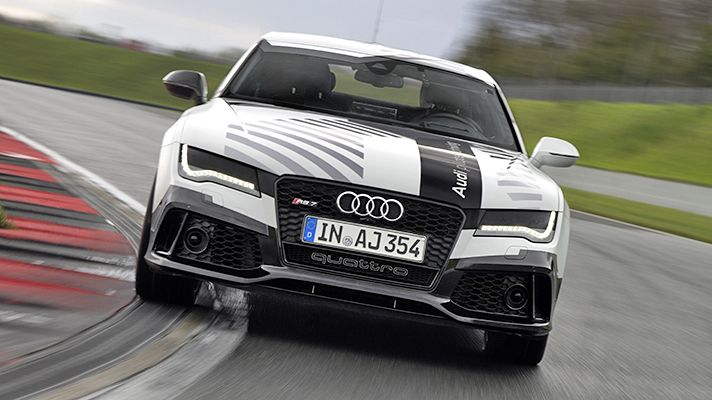The team is working on the creation of a ‘brain'. While current generation cars have a bunch of ECUs individually dealing with separate functions, an autonomous car requires one, central ECU - essentially replicating the human brain - that handles every one of the car's functions. With them all together in one place, this brain can then decide which action is most appropriate in a given scenario.
The 'brain' works in tandem with a central sensor unit, essentially the car's bearings, which act as an indicator of the car's balance. "They speak to each other and compare each other, and if there is a different calculation result the car will shut down," says Glaser. "It will hand back to the driver and if the driver doesn't react the car will slow down and stop by itself."
If the car senses a discrepancy, the driver has ten seconds to take control otherwise it coasts itself to a halt. Very ED-209, you'll agree, though slightly less violent.
What about the fully automated experience Google's shown us?
Climbing in and having a sleep, coming home after six pints or sending the car out to pick the kids up from school is still some way off yet.
"Maybe that's a goal for the future" Glaser tells us, "but in our opinion that's not possible now. There must be an infrastructure beyond the car itself". This includes the introduction of car-to-car communication and some real development of the legal situation, specifically accident liability, surrounding autonomous cars.
So what about this RS7?
The car about to drive me around Motorsport Arena Oschersleben in northern Germany has been lapping all day, cutting its times as the track has dried and its intelligence has increased. This is rather intimidating, as first I have to set my own lap time to compare against the clever-clogs car.
And ‘intimidating' is the key word. After two warm-up laps behind a hastily driven RS6 pace car, I'm set free and put against the clock. Knowing I'm against a potentially perfect machine only heightens my keenness to prove humans still have a place in the world. I pile pressure on myself and miss the apex of turn one by what feels like several counties.
The 552bhp RS7, albeit blooming fast, is a big old beast, and a traditional ‘brake, turn, go' approach only seems to reveal understeer, so it's time to get creative.
From turns six through 13 I crank up the aggression a little, turning in on the brakes to try and counter its keenness to wash wide. It's quite fun actually, and I briefly forget I'm against the clock. Until turn 14 which takes me to the finish line, that is; I barrel in rather too quickly and un-heroically understeer, costing myself vital time, no doubt. I cross the line a little crestfallen. That is surely the driver error that autonomous machines will nullify.
And the automated car's fast lap?
At the cost of some dramatic photographs, Audi stops short of sending us around completely at the whim of a boot full of hardware, and straps a development driver into the captain's chair just in case.
I'm pleased to report he's completely redundant, though less pleased at how neat, tidy and lacking in mistakes ‘AJ' is (the car is named after AJ Foyt, a rather successful American racer). AJ brakes much later than me, yet seems to carve a smoother line through corners, turning with a deftness I was lacking. Some solace comes in the computer's complete avoidance of kerbs and a couple of early upshifts out of corners, executed for safety's sake I'm told.
Somewhat similarly to the classic ‘lean forward' of the celebrities who've starred in the reasonably priced car, I scamper quickly to the screen displaying our lap times. And I'm not ashamed to say (alright, I'm a little ashamed to say) I punch the air with joy. My 1m58.3s lap beats AJ's 2m01.6s.












24
Comment